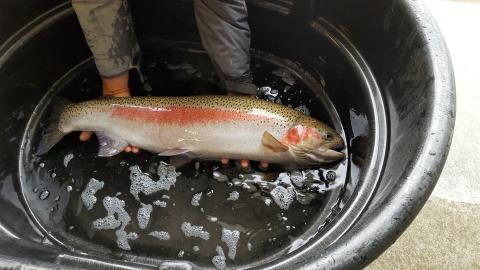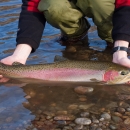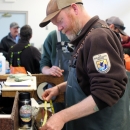The Winthrop NFH steelhead program is an integrated recovery hatchery program. This means it aims to boost abundance of natural spawning by using wild adults and allowing most of their offspring to spawn in the wild. Both the hatchery and wild fish are considered to be part of the same Upper Columbia population. Both are listed under the Endangered Species Act (ESA).
The program has been in almost constant evolution since it began over 12 years ago. Program changes primarily aim at reducing the program's ecological "footprint" on ESA-listed species, by selecting wild fish adapted to the natural environment, not those that have evolved to thrive in the hatchery environment. Other ongoing strategies and research aim to reduce the number of non-migrant juvenile steelhead being released into the environment, as well as cooperative stock management with the Wells Fish Hatchery (Douglas PUD) to better manage gene flow in the river.
We experimented with a new strategy in 2020 to minimize the effects of removing wild broodstock broodstock
The reproductively mature adults in a population that breed (or spawn) and produce more individuals (offspring or progeny).
Learn more about broodstock from the run by seeking to "borrow" fish temporarily for the hatchery program. Part of this goal has already been addressed. Since 2012, US Fish & Wildlife Service has teamed up with the Yakama Nation to live-spawn all female steelhead. Eggs are removed from the females, which are then transferred to the Yakama's Kelt Recovery facility on the Winthrop NFH campus.
Unlike most other Pacific salmon, steelhead do not necessarily die after spawning. Some females survive to spawn a second, or even third time. Due to the difficulty of navigating a highly modified Columbia River environment, their success rate is very low, likely under 5%. The Yakama's program reconditions these "kelt" females and releases them to spawn again, drastically increasing their success rate.
2020 marks the first year that zero steelhead were euthanized for spawning at Winthrop NFH, which is very atypical of a hatchery program! Like the females, all male steelhead were released to the river after being live-spawned. This will, we hope, allow them to contribute wild genetics to the spawning population. The Mid-Columbia Fish & Wildlife Conservation Office's Hatchery Evaluation program PIT-tagged all of these fish and hopes to document whether this is an effective strategy.








